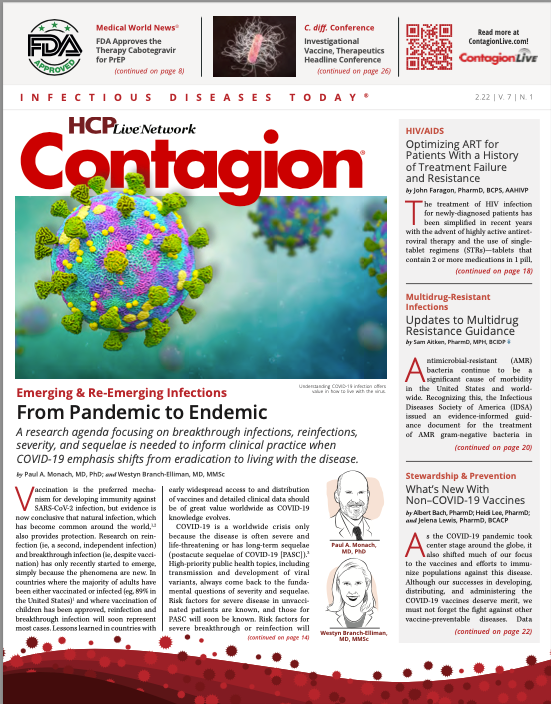From Pandemic to Endemic
A research agenda focusing on breakthrough infections, reinfections, severity, and sequelae is needed to inform clinical practice when COVID-19 emphasis shifts from eradication to living with the disease.
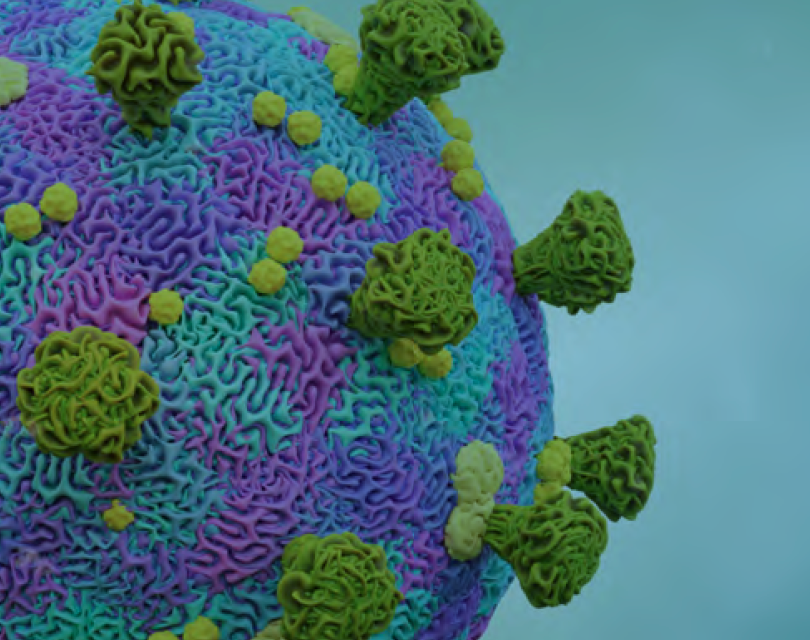
Vaccination is the preferred mechanism for developing immunity against SARS-CoV-2 infection, but evidence is now conclusive that natural infection, which has become common around the world,1,2 also provides protection. Research on reinfection (ie, a second, independent infection) and breakthrough infection (ie, despite vaccination) has only recently started to emerge, simply because the phenomena are new. In countries where the majority of adults have been either vaccinated or infected (eg, 89% in the United States)1 and where vaccination of children has been approved, reinfection and breakthrough infection will soon represent most cases. Lessons learned in countries with early widespread access to and distribution of vaccines and detailed clinical data should be of great value worldwide as COVID-19 knowledge evolves.
COVID-19 is a worldwide crisis only because the disease is often severe and life-threatening or has long-term sequelae (postacute sequelae of COVID-19 [PASC]).3 High-priority public health topics, including transmission and development of viral variants, always come back to the fundamental questions of severity and sequelae. Risk factors for severe disease in unvaccinated patients are known, and those for PASC will soon be known. Risk factors for severe breakthrough or reinfection will undoubtedly overlap to some degree, but we already know the immune status of the individual will play a major role.
This article will discuss how the current evidence about immunity acquired through infection and/or vaccination points to urgent areas of research that would not just serve public health but could be used to tailor clinical treatment for individuals as society moves away from eradication and toward living with SARS-CoV-2.
NATURAL INFECTION AND VACCINATION: SUMMARY OF CURRENT EVIDENCE
The literature on immunity conferred by infection or vaccination was recently reviewed comprehensively by the US Centers for Disease Control and Prevention (CDC), and we refer the reader to that document4 for most references. We will focus on areas where ongoing uncertainties point to urgent research priorities. The following statements can be made with confidence as a starting point for identifying clinically relevant research gaps:
- One dose of messenger RNA (mRNA) vaccine confers moderate and temporary protection to an individual with no history of infection, in adults and adolescents.
- Infection confers protection from severe disease.
- A complete vaccine course confers protection against infection and strong protection against severe disease for well over 6 months in many adults, but not in all.
- The optimal initial dosing interval is not known, but an 8-to-12-week period between the first and second doses confers a stronger antibody response than shorter intervals.5,6
- Individuals previously infected and subsequently vaccinated are better protected than those who have only been vaccinated7 or infected.8 One dose of mRNA vaccine in individuals with a history of infection is sufficient when antibody levels are used for that assessment.4-9
- It is not clear whether previous infection or 1 course of vaccine confers better long-term protection, nor how long the protection against severe disease lasts.
- Immunity against any infection wanes over time, and an additional dose of vaccine increases protection.10 Durability of the protection conferred by a third dose is unknown.
- Neutralizing antibody titers are correlated with resistance to infection but are not a perfect surrogate marker, and antibody/immunoglobulin (IgG) titers to the spike protein are correlated imperfectly with neutralizing antibodies.
- T-cell responses are detectable after vaccination or infection and are presumed to be highly relevant to clinical protection,9 but correlation with protection has not been studied to the same degree as correlation with antibodies.
- Antibody and T-cell responses and their decay after vaccination or infection vary widely, even within the general population.4,9,11,12
- Cross-protection against different viral variants occurs, but is often attenuated, at the antibody and T-cell levels.
- Cross-protection against any infection vs severe disease varies depending upon the specifics of the variant in question.
- Immune-suppressed patients, who are more susceptible to severe COVID-19 in the absence of vaccination,13 often make weak antibody responses to a standard course of vaccine; some but not all achieve better responses after an additional dose.14-17
We will provide a more detailed discussion of several topics before proceeding to suggestions about priorities for future research.
Comparison of immunity conferred by vaccination vs prior infection. Few studies so far, one not yet peer-reviewed, have compared risks of severe reinfection vs severe breakthrough infection. All can be criticized based on high risk of confounding. They have reached different conclusions about whether the protection provided by vaccination is better, worse, or no different from that provided by infection, but all support the notion that both vaccination and infection provide substantial immunity.4,18,19
Optimal initial dosing intervals and booster doses. In clinical trials, the 2 doses of Pfizer/BioNTech vaccine BNT162b2 were spaced 3 weeks apart, and the 2 doses of Moderna vaccine mRNA-1273 were spaced 4 weeks apart. With these intervals, waning of immunity against any infection is clinically apparent in many individuals by 6 months, and even shorter against Omicron; duration of protection against severe disease is less clear. Some countries, including the United Kingdom and Canada, adopted a longer interval between the 2 doses of the initial vaccination series as a means of accelerating delivery of a first dose, but that strategy may also have improved the duration of response.5,6 In countries where booster shots can be widely administered, the timing of the initial regimen may be less important, but the optimal timing and frequency of booster shots in the general population, high-risk populations, and previously infected patients remains an important consideration, especially with the spread of variants.
Vaccination in immune-suppressed patients. IgG titers are lower after a standard course of vaccination in patients on immune-suppressive drugs, and immune-suppressed states are probably a major risk factor for breakthrough infection requiring hospitalization: In one US study, 40% of hospitalized breakthrough cases (including 8 of 17 fatal breakthrough cases) were immune-suppressed, whereas 15% of unvaccinated patients were immune-suppressed.20 The degree of reduction varies widely among different drugs and underlying conditions, with results overall being consistent with known mechanisms of action.16,17 A third dose of mRNA vaccine increases IgG levels substantially in some but not all immune-suppressed patients, and there is particular concern that patients with profound deficits in humoral immunity, either due to disease states or B-cell–depleting therapy, cannot be effectively immunized.16,21
Immune responses. Standard vaccine regimens produce well over 90% protection against severe disease for at least 6 months in most individuals; thus, extremely high IgG titers are not necessary for protection against severe disease. However, multiple studies confirm a correlation between IgG levels (whether tested for neutralizing activity or simply binding the spike protein) and protection against infection of any severity.4 Because IgG titers also vary widely after infection or vaccination and decay over time to variable degrees,9,11,12,14,15,22,23 time since vaccination or infection might not be the best predictor for risk of breakthrough or reinfection if IgG titers were available on an individual basis. Higher titers, as measured against the ancestral spike protein, may be needed to provide cross-protection against different variants.
Implications of the gaps in evidence. Toward the goal of devising policy and clinical guidance to protect individuals and the overall population as effectively and efficiently as possible, urgent questions are:
Who is at risk for reinfection or breakthrough infection, and in particular infection that is severe or has prolonged sequelae?
Why do these patients remain at risk? Can IgG titers be used along with other health factors to make more precise risk-stratification for individual patients?
When do these infections occur (ie, what is the contribution of time since infection or vaccination in determining risk, independent of other measurable factors)?
Answers to these questions could be used to refine recommendations about revaccination strategies and public policy about mitigation measures and vaccine mandates, to the benefit of society as a whole and to individual patients. Identification of who is at risk and when could be used to inform preexposure and postexposure prophylaxis strategies with monoclonal antibodies, especially those that can be self-administered, and/or antiviral drugs, especially if available orally (Figure). Prophylaxis and early antivirals in high-risk patients would not only reduce individual risk but also protect society by limiting spread and prolonged infections in immunocompromised patients, which may contribute to the development of problematic new variants.24
STEPS TOWARD CLOSING THE INFORMATION GAP
A proposed research agenda for studying reinfection and breakthrough infection is shown in Box. Clinical scenarios that are important to study are shown in Table. Additional steps to facilitate the usefulness of these studies are as follows.
Definitions of severe infection. Infection with SARS-CoV-2 is only clinically significant if it is severe or has PASC. In May 2021, the CDC started focusing on the subset of breakthrough infections that lead to hospitalization, and a recent study aimed at estimating vaccine effectiveness used a rigorous case definition.20
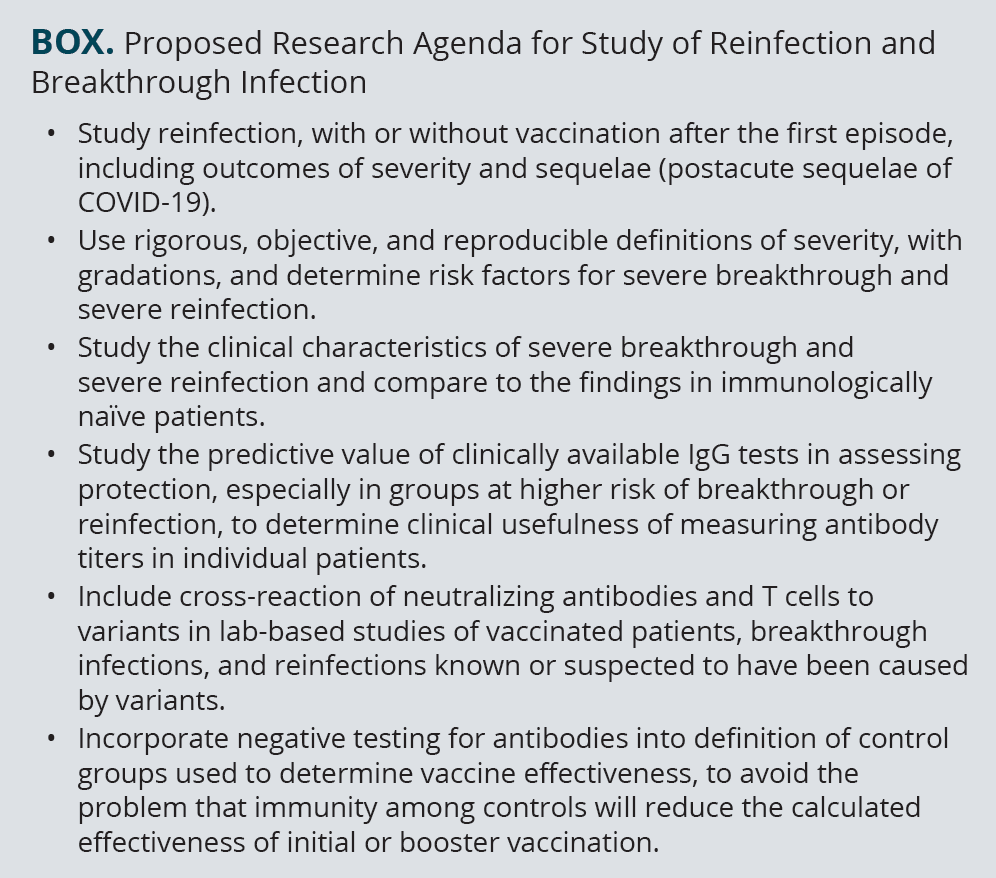
However, use of the metric “hospitalization contemporaneous with a positive test” to identify severe cases in hospitals that screen all inpatients for SARS-CoV-2 will magnify risk of hospitalization due to COVID-19 and make it more difficult to answer clinically important questions.25 More precise—but still simple and objective—definitions of moderate to severe COVID-19 are needed, as is research to determine whether concomitant SARS-CoV-2 infection worsens outcomes of other serious medical conditions.26 Finally, to determine risk factors for severe breakthrough or reinfection, comparator groups must include patients with nonsevere infection. Data collection from only hospitalized patients will not allow such analysis.20
Vaccination strategies for individuals previously infected or previously vaccinated. Multiple studies demonstrate that IgG titers are higher after 1 dose of mRNA vaccine in previously infected patients than they are after 2 doses in patients with no history of infection.4,9,27-30 This evidence should be sufficient to determine policy, but clinical protection against severe disease and PASC will also need to be evaluated. Study of clinical protection in individuals who have been vaccinated without prior or subsequent infection should also include time between the initial doses in 2-dose regimens, time until and after an extra dose, and the specific vaccines used. Over time, the known or likely variant responsible for infection will become another important variable.
Moving toward clinical use of antibody testing in high-risk groups. Determining IgG titers that correlate with different levels of protection against any infection and specifically severe disease would inform clinical decision-making. After additional study, IgG titers could be used to predict those at risk of severe reinfection or breakthrough infection, particularly among populations at high risk of limited vaccine response based on age, immune suppression, or other factors. Rather than only providing odds ratios comparing populations, studies of IgG should include metrics for classification, with the most useful being positive and negative likelihood ratios at cutoff values using commercially available assays. Even a moderately helpful correlate of immunity would be preferable to making a guess based on a patient’s age, comorbidities, and time since vaccination or infection. Relevance to viral variants will need to be assessed, either by using existing assays or variant-specific assays.
Developing new methods to calculate vaccine effectiveness. Many of the vaccine effectiveness trials use “test-negative designs,” which means vaccinated cases are compared with controls with negative test results for current SARS-CoV-2 infection. However, over time, the control arms increasingly include a higher proportion of individuals with natural immunity, and the calculated protection conferred by vaccination will be artificially reduced simply due to naturally acquired immunity in the control arm. These challenges are compounded when measures of disease severity are not considered. Developing new strategies for estimating effectiveness, or incorporating antibody testing when defining the control group, would help mitigate this challenge.
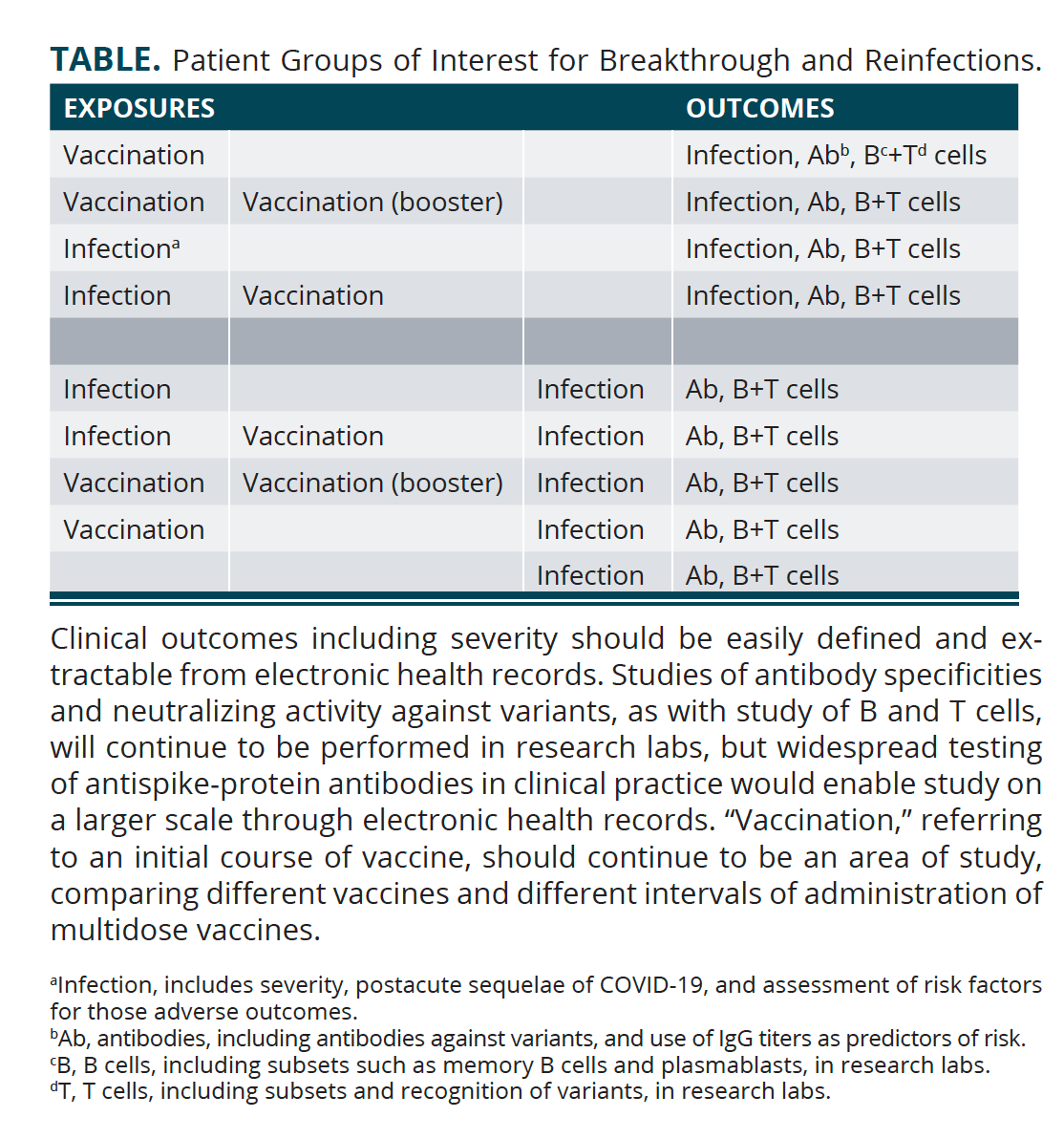
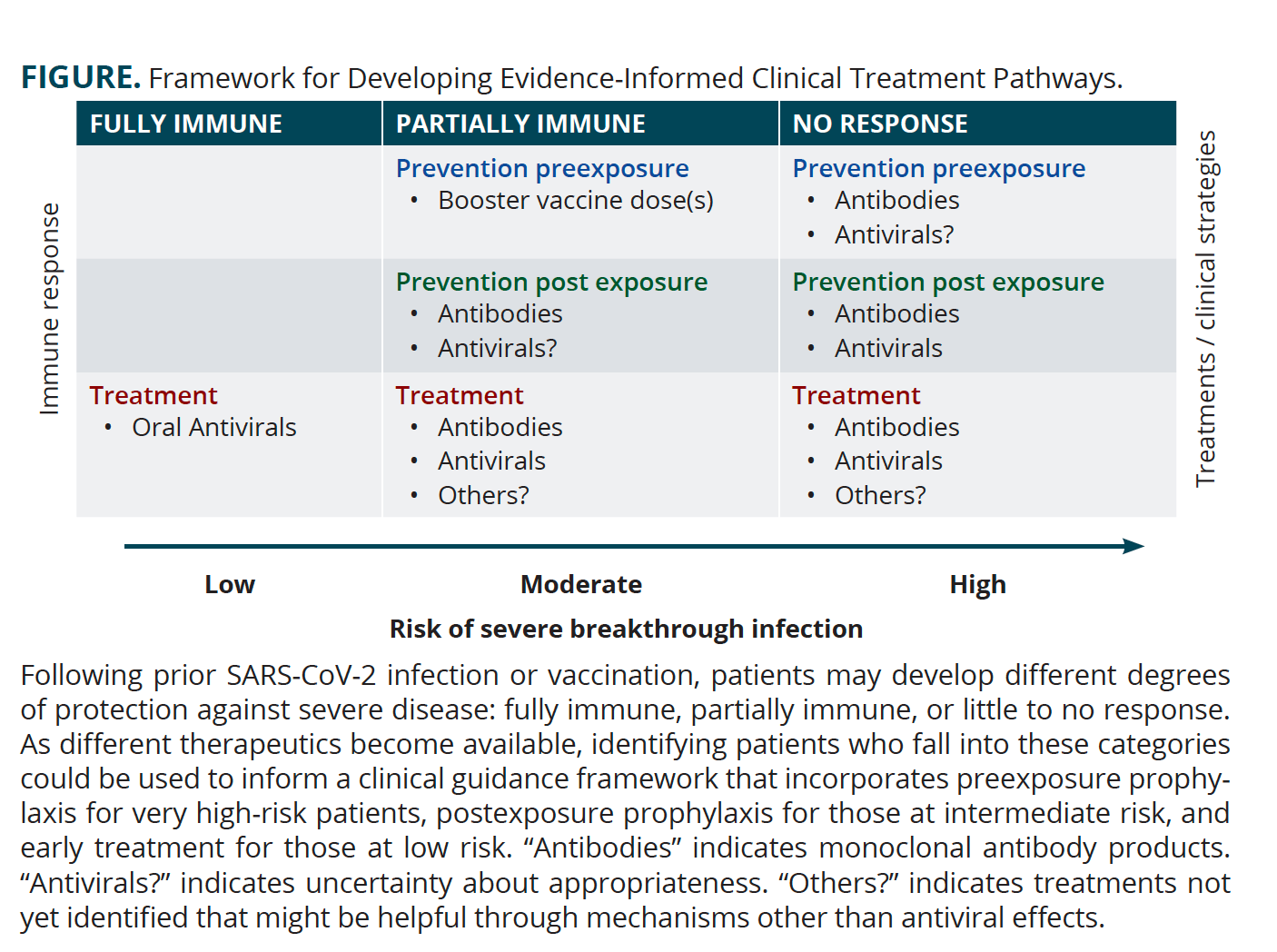
Identification of nonresponders and suboptimal responders to vaccination. As more individuals become immune to SARS-CoV-2, a progressively higher proportion of infections will be in those who either never developed immunity to the vaccine or had relatively early waning of protection. This phenomenon is again likely to inappropriately deflate calculations of vaccine effectiveness for the general population. Research is needed to classify individuals as (1) nonresponders (many immunocompromised patients), (2) those with waning immunity (likely older and chronically ill patients), or (3) those with longer-term protection against severe disease. Patients identified as being at high risk of vaccine nonresponse could be targeted for preexposure or postexposure prophylaxis with antiviral treatments, and those with waning immunity could be prioritized for additional vaccine doses (Figure).
CONCLUSION
Provided health care workforce shortages caused by even mild infections do not strain the health care system beyond capacity, the percentage of adults in many higher-income countries who have at least partial immunity to SARS-CoV-2 is likely approaching what is needed to prevent hospitals from becoming overwhelmed with severely ill patients, provided new variants that are both vaccine resistant and highly virulent do not emerge. Substantial uncertainty continues regarding the potential for additional pandemic waves, but some individuals will remain at risk of severe disease or long-term sequelae when SARS-CoV-2 becomes an endemic disease. Answering research questions about breakthrough and reinfection with a focus on severity and long-term sequelae promises to greatly improve the care received by the vast number of individuals worldwide who want to minimize their risks of severe COVID-19 and PASC. Relatively minor but useful changes in policy on vaccination could be made now based on existing data, and more sweeping changes should be considered to move the approaches to prevention of severe COVID-19 and PASC from the realm of population-based guidelines to decision-making about individual patients.
References
1. Jones JM, Stone M, Sulaeman H, et al. Estimated US infection- and vaccine-induced SARS-CoV-2 seroprevalence based on blood donations, July 2020-May 2021. JAMA. 2021;326(14):1400-1409. doi:10.1001/jama.2021.15161
2. Bobrovitz N, Arora RK, Cao C, et al. Global seroprevalence of SARS-CoV-2 antibodies: a systematic review and meta-analysis. PloS One. 2021;16(6):e0252617. doi:10.1371/journal.pone.0252617
3. Al-Aly Z, Xie Y, Bowe B. High-dimensional characterization of post-acute sequelae of COVID-19. Nature. 2021;594(7862):259-264. doi:10.1038/s41586-021-03553-9
4. Science brief: SARS-CoV-2 infection-induced and vaccine-induced immunity. In: National Center for Immunization and Respiratory Diseases (NCIRD), Division of Viral Diseases. CDC COVID-19 Science Briefs. Atlanta (GA): Centers for Disease Control and Prevention (US); October 29, 2021.
5. Payne RP, Longet S, Austin JA, et al; PITCH Consortium. Immunogenicity of standard and extended dosing intervals of BNT162b2 mRNA vaccine. Cell. 2021;184(23):5699-5714.e11. doi:10.1016/j.cell.2021.10.011
6. Skowronski DM, Setayeshgar S, Febriani Y, et al. Two-dose SARS-CoV-2 vaccine effectiveness with mixed schedules and extended dosing intervals: test-negative design studies from British Columbia and Quebec, Canada. MedRxiv. Published online October 26, 2021. doi:10.1101/2021.10.26.21265397
7. Abu-Raddad LJ, Chemaitelly H, Ayoub HH, et al. Association of prior SARS-CoV-2 infection with risk of breakthrough infection following mRNA vaccination in Qatar. JAMA. 2021;326(19):1930-1939. doi:10.1001/jama.2021.19623
8. Cavanaugh AM, Spicer KB, Thoroughman D, Glick C, Winter K. Reduced risk of reinfection with SARS-CoV-2 after COVID-19 vaccination - Kentucky, May-June 2021. MMWR Morb Mortal Wkly Rep. 2021;70(32):1081-1083. doi:10.15585/mmwr.mm7032e1
9. Geers D, Shamier MC, Bogers S, et al. SARS-CoV-2 variants of concern partially escape humoral but not T-cell responses in COVID-19 convalescent donors and vaccinees. Sci Immunol. 2021;6(59):eabj1750. doi:10.1126/sciimmunol.abj1750
10. Bar-On YM, Goldberg Y, Mandel M, et al. Protection of BNT162b2 vaccine booster against Covid-19 in Israel. N Engl J Med. 2021;385(15):1393-1400. doi:10.1056/NEJMoa2114255
11. Walsh EE, Frenck RW Jr, Falsey AR, et al. Safety and immunogenicity of two RNA-based Covid-19 vaccine candidates. N Engl J Med. 2020;383(25):2439-2450. doi:10.1056/NEJMoa2027906
12. Widge AT, Rouphael NG, Jackson LA, et al; mRNA-1273 Study Group. Durability of responses after SARS-CoV-2 mRNA-1273 vaccination. N Engl J Med. 2021;384(1):80-82. doi:10.1056/NEJMc2032195
13. Conway R, Grimshaw AA, Konig MF, et al; COVID-19 Global Rheumatology Alliance. SARS-CoV-2 infection and COVID-19 outcomes in rheumatic disease: a systematic literature review and meta-analysis. Arthritis Rheumatol. Published online November 22, 2021. doi:10.1002/art.42030
14. Furer V, Eviatar T, Zisman D, et al. Immunogenicity and safety of the BNT162b2 mRNA COVID-19 vaccine in adult patients with autoimmune inflammatory rheumatic diseases and in the general population: a multicentre study. Ann Rheum Dis. 2021;80(10):1330-1338. doi:10.1136/annrheumdis-2021-220647
15. Prendecki M, Clarke C, Edwards H, et al. Humoral and T-cell responses to SARS-CoV-2 vaccination in patients receiving immunosuppression. Ann Rheum Dis. 2021;80(10):1322-1329. doi:10.1136/annrheumdis-2021-220626
16. Deepak P, Kim W, Paley MA, et al. Effect of immunosuppression on the immunogenicity of mRNA vaccines to SARS-CoV-2: a prospective cohort study. Ann Intern Med. 2021;174(11):1572-1585. doi:10.7326/M21-1757
17. Jena A, Mishra S, Deepak P, et al. Response to SARS-CoV-2 vaccination in immune mediated inflammatory diseases: systematic review and meta-analysis. Autoimmun Rev. 2022;21(1):102927. doi:10.1016/j.autrev.2021.102927
18. Bozio CH, Grannis SJ, Naleway AL, et al. Laboratory-confirmed COVID-19 among adults hospitalized with COVID-19–like illness with infection-induced or mRNA vaccine-induced SARS-CoV-2 immunity - nine states, January-September 2021. MMWR Morb Mortal Wkly Rep. 2021;70(44):1539-1544. doi:10.15585/mmwr.mm7044e1
19. Gazit S, Shlezinger R, Perez G, et al. Comparing SARS-CoV-2 natural immunity to vaccine-induced immunity: reinfections versus breakthrough infections. MedRxiv. Published online August 25, 2021. doi:10.1101/2021.08.24.21262415
20. Tenforde MW, Self WH, Adams K, et al; Influenza and Other Viruses in the Acutely Ill (IVY) Network. Association between mRNA vaccination and COVID-19 hospitalization and disease severity. JAMA. 2021;326(20):2043-2054. doi:10.1001/jama.2021.19499
21. Mrak D, Tobudic S, Koblischke M, et al. SARS-CoV-2 vaccination in rituximab-treated patients: B cells promote humoral immune responses in the presence of T-cell–mediated immunity. Ann Rheum Dis. 2021;80(10):1345-1350. doi:10.1136/annrheumdis-2021-220781
22. Tarke A, Sidney J, Methot N, et al. Impact of SARS-CoV-2 variants on the total CD4 + and CD8 + T cell reactivity in infected or vaccinated individuals. Cell Rep Med. 2021;2(7):100355. doi:10.1016/j.xcrm.2021.100355
23. Redd AD, Nardin A, Kared H, et al. CD8+ T-cell responses in COVID-19 convalescent individuals target conserved epitopes from multiple prominent SARS-CoV-2 circulating variants. Open Forum Infect Dis. 2021;8(7):ofab143. doi:10.1093/ofid/ofab143
24. Corey L, Beyrer C, Cohen MS, Michael NL, Bedford T, Rolland M. SARS-CoV-2 variants in patients with immunosuppression. N Engl J Med. 2021;385(6):562-566. doi:10.1056/NEJMsb2104756
25. Fillmore NR, La J, Zheng C, et al. The COVID-19 hospitalization metric in the pre- and post-vaccination eras as a measure of pandemic severity: a retrospective, nationwide cohort study. Research Square. Published online September 13, 2021. doi:10.21203/rs.3.rs-898254/v1
26. Saad M, Kennedy KF, Imran H, et al. Association between COVID-19 diagnosis and in-hospital mortality in patients hospitalized with ST-segment elevation myocardial infarction. JAMA. 2021;326(19):1940-1952. doi:10.1001/jama.2021.18890
27. Krammer F, Srivastava K, Alshammary H, et al. Antibody responses in seropositive persons after a single dose of SARS-CoV-2 mRNA vaccine. N Engl J Med. 2021;384(14):1372-1374. doi:10.1056/NEJMc2101667
28. Ferrari D, Di Resta C, Tomaiuolo R, et al. Long-term antibody persistence and exceptional vaccination response on previously SARS-CoV-2 infected subjects. Vaccine. 2021;39(31):4256-4260. doi:10.1016/j.vaccine.2021.06.020
29. Havervall S, Marking U, Greilert-Norin N, et al. Antibody responses after a single dose of ChAdOx1 nCoV-19 vaccine in healthcare workers previously infected with SARS-CoV-2. EBioMedicine. 2021;70:103523. doi:10.1016/j.ebiom.2021.103523
30. Reynolds CJ, Pade C, Gibbons JM, et al. Prior SARS-CoV-2 infection rescues B and T cell responses to variants after first vaccine dose. Science. Published online April 30, 2021. doi:10.1126/science.abh1282
